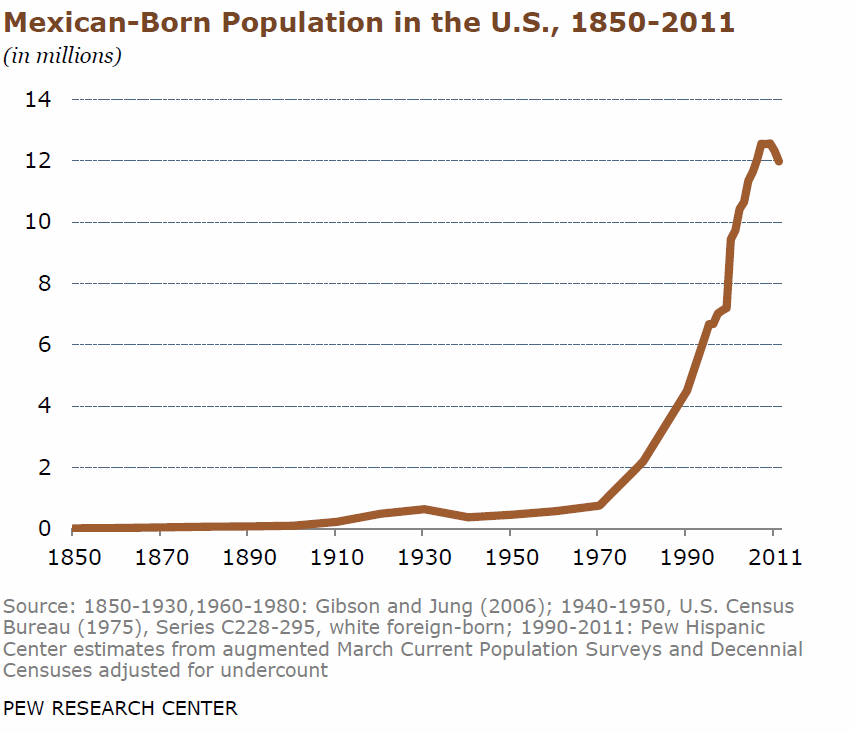American Dream Goin’ South

By John Seiler
People naturally move from depressed countries to thriving countries. That’s especially true when travel between the two countries is easy, as it is between the United States and Mexico.
Because so many Mexicans have come to the United States, pressures have risen to give even illegal immigrants access to tax-funded student loans. A writer I’ve read a lot over the years, Gustavo Arellano of the OC Weekly, writes the paper’s ¡Ask a Mexican! column. I like how he flavors his articles with a few Spanish words, much as H.L. Mencken did with German words a century ago.
In his current column, Arellano writes about the advance of the California Dream Act scholarships last year, whose actual official title is: the Development, Relief, and Education for Alien Minors Act. And about the federal Dream Act. He quotes the California law’s author, Assemblyman Gil Cedillo, D-Los Angeles, who “ceaselessly supports DREAMers.”
Cedillo explained: “[S]tudents will have the opportunity to receive Cal Grants, Board of Governors Fee Waivers (for community-college students) and other state-funded scholarships.”
But the legislation comes too late. The California and American dreams have turned into economic nightmares, even as Mexico’s economy has turned into the real dream, leading immigrants to return home.
The Pew Hispanic Center’s recent report found:
“After four decades that brought 12 million current immigrants—most of whom came illegally—the net migration flow from Mexico to the United States has stopped and may have reversed, according to a new analysis of government data from both countries….”
Here’s Pew’s graph:
You’ll notice the previous time the numbers dropped: the 1930s. That was during the Great Depression, when many immigrants returned home because U.S. unemployment soared above 25 percent. It was a global depression, so people might not have gotten jobs back in Italy, France, Sweden or Mexico. More people were farmers back then, and a family farm could make us of extra hands.
Curiously, that’s a reason mentioned in this short RT video about current immigrants returning home:
This shows that what America is going through now may not really be the time after the Great Recession, but the middle part of the Greater Depression. Although the official California unemployment rate is 10.9 percent, the real level — including those working part time who want to work more and those who have given up looking for work — is 25 percent, just as during the 1930s, as I have reported.
A difference this time from the 1930s is that Mexico’s economy is not also in a slump, but is a hot tamale:
“First-quarter growth was 4.6 per cent compared with a year earlier, the fastest pace since the third quarter of 2010, prompting several analysts to upgrade 2012 growth forecasts.”
U.S. decline
The Pew study noted,
“It is possible that the Mexican immigration wave will resume as the U.S. economy recovers.”
However, this seems unlikely because U.S. economic growth will remain sluggish for many more years. In particular, residential and business construction, which employed hundreds of thousands of immigrants until the real-estate bust of 2006-07, remains overbuilt. Compared to a year before, home prices in April 2012 declined 3.1 percent in Los Angeles County and 2.3 percent in Orange County; although prices did rise 2.4 percent in San Diego county, and rose in the long-depressed counties of Riverside, 5.3 percent, and San Bernardino, 5.9 percent.
The reason the United States is so underperforming compared to Mexico is because of the nations’ debt loads. Everybody is seeing how high government debt is imploding the economies of Portugal, Italy, Ireland, Greece and Spain (the PIIGS). But consider these numbers of public indebtedness by country. This is a U.S.-Mexico comparision I don’t think anyone else has made.
Debt by percent of GDP (CIA and Eurostat data), least to most:
8.7 Russia
10.1 Hong Kong
30.3 Australia
37.5 Mexico
38.7 Switzerland
54.4 Brazil
43.5 China
69.3 Spain
82.0 Germany
83.5 Canada
86.5 France
103 United States
108.4 Ireland
108.5 Portugal
120.9 Italy
165.3 Greece
208.2 Japan
230.8 Zimbabwe.
Mexican and U.S. debt
Some comments: Japan is an anomaly because it has borrowed heavily to rebuild after the March 2011 Tohoku earthquake and Tsunami. Although its high debt before that had helped retard economic growth during the past two “lost decades” there.
Zimbabwe, of course, is an economic basket case from dictator Mugabe’s socialist confiscation policies. Spain’s relatively low debt, 69.3 percent, means it might fare rather well in the ongoing European crisis.
The big thing to notice is that Mexico’s debt is just 37.5 percent of GDP, a bit lower than Switzerland’s 38.7 percent. ¡Excelente!
By contrast, the U.S. debt is 103 percent. Terrible. That’s more than two-and-a-half times as large as Mexico’s ratio.
A big reason for the U.S. debt is the huge military commitment overseas. By contrast, Mexico has no imperial ambitions. Its war on drug dealers — foisted on it by by Tio Samuel — at least wastes the money at home.
Mexico also has a young population, whereas America’s is shifting into its Baby Boomer retirement phase, in which well-educated Boomers drop out of the work force — and, as they head for the links, start soaking up Social Security and Medicare, not to mention Metamucil.
Government debt is like family credit cards. Suppose your family income is $60,000, which it is for many Californians. A 38.7 percent debt means you own $23,220 on the plastic. Not great, but manageable if you’re frugal.
But a 103 percent debt is $61,800, which is difficult even to sustain, let alone pay off.
It’s true that the U.S. government currently pays really low interest rates. That’s because the Federal Reserve Board is keeping rates low. As my colleague Wayne Lusvardi has shown, artificially low interest rates are devastating the private economy because families, in their private savings, actually are losing money from inflation. So the low interest rates that help the government debt are undermining the private economy that is the foundation of the whole government structure. That’s why I expect the Fed, after the election, will jack up interest rates, just as Fed Chairman Paul Volcker did in the late 1970s to kill the 1970s inflation.
But that will meain higher interest paid on the federal government’s current national debt of $15.7 trillion — and rising.
It’s a Catch 22 that cannot have a good ending.
Recent economic history
Mexico also has had more pro-market presidents in recent decades. President Reagan obviously was pro-market. But his successor, President George H.W. Bush, increased taxes in 1991, crashing the economy. In 1993-94, President Bill Clinton raised taxes and tried to push Hillarycare into law.
But after his actions led to the Republicans taking over Congress in 1995, Clinton switched. He dropped Hillarycare; cut taxes — twice; and enacted welfare reform. The dot-com boom ensued. A mild recession began in 2000. But Clinton left office enjoying the first budget surpluses in 30 years.
In 2001, President George W. Bush panicked after 9/11, and went on a wild spending spree, turning the Clinton surpluses into record deficits. At the same time Federal Reserve Chairman Alan Greenspan, also panicked over unbased economic worries after 9/11 and debased the dollar, causing the inflation we’ve suffered since then; and kept interest rates artificially low, sparking the boom-bust in housing. (There were other reasons for the housing boom-bust, including shady bank loans and government easy loans to homeowners.)
Bush’s tax cuts would have helped — but they expired in 2010. Since about 2008, this has caused great uncertainty, because no one knows if the extensions since then will continue, so no one can plan for future tax policy.
After the September 2008 financial crisis, Bush also panicked and signed the infamous TARP bailout of Wall Street, paid for by Main Street. He also imposed the Sarbanes-Oxley absurd regulations on business.
President Obama has continued the Bush policies of wild spending, record deficits and hyper-regulation, especially Obamacare and the absurd Dodd-Frank financial reform disaster. Current Fed Chairman Ben Bernanke has continued the Greenspan policies of easy money and too-low interest rates.
Although America needs financial and business reform, Sarbanes-Oxley and Dodd-Frank were bureaucratic monstronsities that have destroyed businesses and jobs.
Republicans are saying that Mitt Romney, if he becomes president, will improve things. That’s unlikely. His Romneycare in Massachusetts when he was governor there was the model for Obamacare. Romney only would tinker with Obamacare, not get rid of it entirely. And he’s not serious about spending cuts. Any reduction in the trillion-dollar deficits must include major cuts to defense spending. But Romney, on his Web site, even attacks Obama’s proposed “cuts,” which really are just a slowing of massive increases that Obama would continue. Romney admits, “This will not be a cost-free process.”
There is little indication that America will veer away from barreling toward a Greek-style crisis.
Mexican history
Now consider Mexico’s recent presidents. The 1994 devaulation crisis crashed the Mexican economy. But the New York Times later reported of new Presidente Ernesto Zedillo, elected that year, “[T]he tight-money policies and fiscal discipline that he imposed after [the crisis] brought the broad economic indicators back to healthy growth in two years.”
Further free-market reforms have been enacted by Presidente Vicente Fox, elected in 2000, and current Presidente Felipe Calderon, elected in 2006.
Let’s compare them: Since 1994, Mexico has had 17 years of economic policies, 1995-2012, promoting free markets. The United States has had only six years promoting markets, 1995-2000, all under Clinton. The Bush-Obama years, 2001-2012, have been 11 years of assaults on the private economy.
Of course, Mexico has its own problems, especially the horrible drug-gang violence. But that was caused because the drug “war” was pushed on Calderon by Bush. In 2007, Bush gave Calderon $500 million in U.S. taxpayers’ money to heighten the war. Calderon should have told the Yanqui caudillo to keep his money. But it’s hard to say no to a bully with 10,000 nuclear weapons. The Bush-Calderon “war” on drugs meant drug-gang retaliation across Mexico. Of course, almost all the dope ends up in the United States. And the drug “war” is pointless, because the dope still is readily available at low prices. Mexico pays the price in blood for Yanquis getting high.
Perhaps Mexico’s next presidente, elected this year, will reverse this process, and even legalize drugs, as has been urged by ex-Presidente Fox.
After Portugal legalized drugs a decade ago, drug use actually declined. Drug addiction has been treated as a medical, not a criminal, problem. With no profit motive, the pushers don’t push drugs on kids, or fight turf wars.
A combination of continued economic growth and ending the drug violence through legalization would turbocharge the attractiveness of Mexico’s economy. Likely millions more immigrants to the United States would return home.
Goin’ South
 Not only that. Millions of gringos would head South, seeking jobs and freedom. Among the many ways Mexico is freer than El Norte, South of the border you can smoke and drink most anywhere. And you can buy Cuban cigars legally.
Not only that. Millions of gringos would head South, seeking jobs and freedom. Among the many ways Mexico is freer than El Norte, South of the border you can smoke and drink most anywhere. And you can buy Cuban cigars legally.
The United States government still imposes an embargo on most Cuban goods, especially cigars, because of fears that the Soviet Union will use Cuba as a base for a Red Army invasion, as in the 1984 movie “Red Dawn.” Except that the Soviet Union dissolved 21 years ago. Now we know who’s been using all the drugs the U.S. government confiscated from Mexican drug gangs.
As millions of gringos move South to pursue the bright Mexican Dream, we’ll soon hear complaints about the Yanquis “taking Mexican jobs.” Yanqui defenders will say they’re only “doing jobs Mexicans won’t do.”
And for their children attending university, gringo parents will insist on the Mexican government passing a “Mexican Dream Act.”
Related Articles
Really, CA legislators are brain trusts!
JUNE 24, 2011 By ALI MEYER California legislators can’t seem to get a balanced budget passed or fix the state
POW!!! California $127 billion in the red
April 19, 2013 By Katy Grimes Holy understatement Batman! California is more than $127 billion in the red! The California
Chamber of Commerce touts pension reform, backs pension arsonist
The U.S. Chamber of Commerce stunned a lot of people last month when it endorsed Democrat incumbent Scott Peters over






